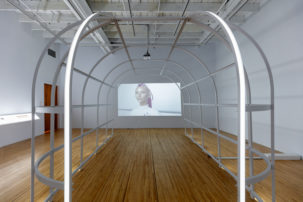Knitting is quiet work, slow work, hard work. It unfolds across hours, resulting in new masses of fabric, accumulating over a series of individual stitches. In many 21st-century North American contexts, knitting might be called materialist—part of a quest for ever more quantities of physical things. At the same time, its knotting and winding can seem almost alchemical, creating new textile bodies out of slimmer-than-slim means.
Knitting—and its processes, materialities and implications—have dominated much of Janet Morton’s previous production. This is most notably the case in massive sculptural installations such as 1999’s Cozy, which encased the entirety of a house on Toronto’s Ward’s Island in knitted fabric. In these and other projects, the artist revels in the potential for excessive tangles of knit fibre to grow beyond the small garments and accessories to which they are typically confined.
Now, in her current show at Paul Petro Contemporary Art, Morton is preoccupied with the fallout of this knitted accumulation, refusing the materialism of both the art and craft worlds.
In some cases—as in two film works that deal with unravelling yarn—Morton’s recent efforts erase the labour and time of her crafted productions.
In Road Trip, a figure walks determinedly while slowly undoing his one-piece white jumpsuit and winding it into a ball which grows more and more unwieldy in his hands. In a short few minutes, the performer undoes hours of Morton’s work.
Shiny Heart initially appears more elegant, beginning as musician Colin Couch intones the first few notes of one of Bach’s Goldberg Variations on his tuba. As the film progresses, a fine grey yarn seems to knit itself around the tuba, covering its elaborately coiling tubes and encasing its bell. This effect is actually generated by playing, in reverse, a film of Morton’s custom-made yarn cover unravelling from the tuba. So while the music (which is not played in reverse) is gracefully performed and echoes forlornly throughout the gallery, a disjunction develops over the course of the film as the frantically “winding” yarn snags on Couch’s fingers, darting around his body in its unrelenting path “up” the instrument.
The covered tuba is a beautiful object, its glory driven home both by a set of photographs on the gallery walls and by luxurious close-ups of the fabric-instrument interplay in the film. All in all, this makes its de-materialization somewhat unnerving. The disconnect between the musician’s skilled performance and the action of the knit-work in its pull to collapse manifests in Couch’s body language, which fails to match up with the forward-played music. As his facial muscles tighten in execution of a difficult series of notes, the audio plays a low lull. The impression is one of awkward striving, which conveys the sense of false simplicity and practiced ease both the musician and the artist cultivate in pursuit of their respective crafts.
Elsewhere, chaotic tangles of yarn emerge in small doses as embroidered additions to photographs: a jet of multicoloured thread projects from a young boy’s mouth, and a man’s ears explode cartoonishly with tangled clouds. Still other works in the collection of small, embroidered black and white photographs tie discourses of natural sciences and anatomy to the portraits’ anonymous sitters.
Morton’s contemporary interventions into such photographs read as recent, but her attention to a nostalgically and scientifically tinged visual vocabulary suggests an unspecified and exciting sense of history. These works present further meditations on time and making, as Morton draws the long-practiced but often-invisible labour of needlework to the surface of these found images.









